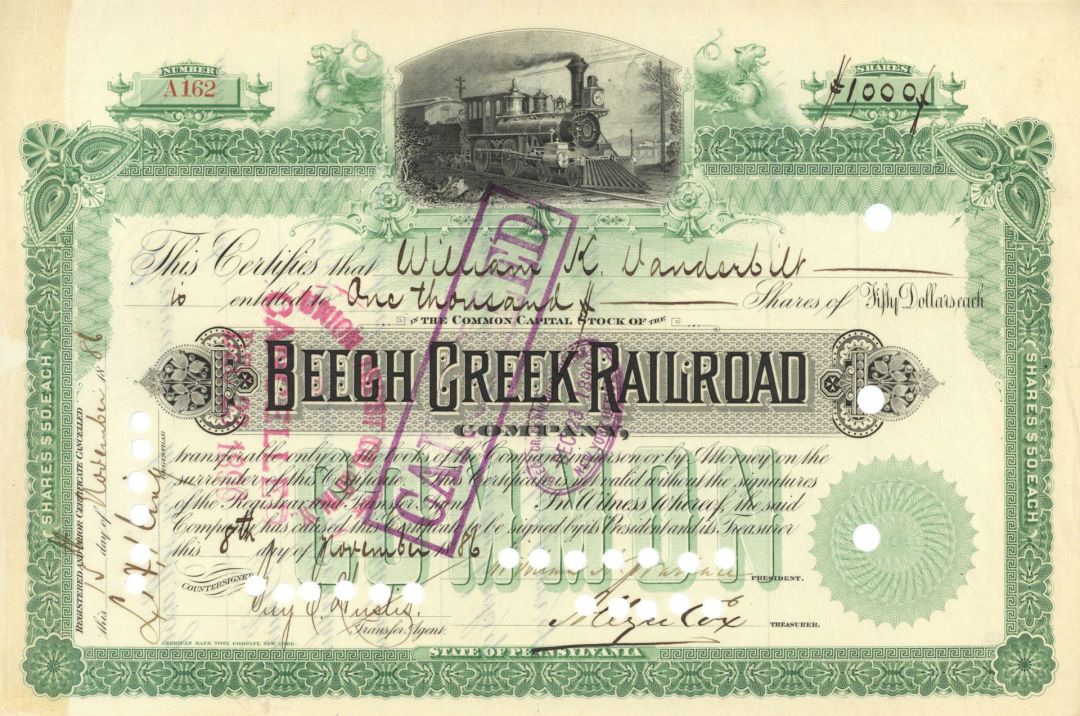Beech Creek Railroad Co. Issued to William Kissam Vanderbilt - 1880's dated Railway Stock Certificate
Inv# AG1827A Stock
Stock Issued to but not signed by Wm. K. Vanderbilt. 1,000 shares! Printed by American Bank Note Company, New York. Portrait and biography included.
William Kissam Vanderbilt (1849-1920) was a notable member of the distinguished Vanderbilt family in the United States. As the second son of William Henry Vanderbilt, he inherited a substantial fortune of $60 million. For a period, he was involved in the management of the family’s railroad enterprises, although his active participation diminished after 1903. His sons, William Kissam Vanderbilt II (1878-1944) and Harold Stirling Vanderbilt (1884-1970), were the final family members to engage in railroad operations, with the latter experiencing a defeat in a proxy battle for control of the New York Central Railroad during the 1950s.
William K. Vanderbilt's first marriage was to Alva Erskine Smith (1853-1933), whom he wed in 1875. Alva, born into a slave-owning family in Alabama, was the mother of his children and played a significant role in compelling their daughter Consuelo (1877-1964) to marry the 9th Duke of Marlborough in 1895. Shortly thereafter, the Vanderbilts divorced, with William K. subsequently marrying Anne Harriman Rutherford Sands, while Alva married Oliver Hazard Perry Belmont. Following the death of his brother Cornelius Vanderbilt II in 1899, William K. was widely recognized as the head of the Vanderbilt family. Like many of his affluent relatives, he constructed opulent residences, including Idle Hour (1900) on Long Island, New York, and Marble House (1892), which was designed by Richard Morris Hunt, the same architect responsible for his mansion at 660 Fifth Avenue (1883) in Newport. William Kissam Vanderbilt passed away in Paris, France, in 1920. His remains were returned to the United States and interred in the Vanderbilt family vault located in the Moravian Cemetery at New Dorp on Staten Island, New York.
The Beech Creek Railroad was a now-defunct railway that functioned in central Pennsylvania, connecting Jersey Shore and Mahaffey. It was initially chartered in 1882 and subsequently leased to the New York Central and Hudson River Railroad, which later became known as the New York Central Railroad, in 1890. Following this lease, the railroad was operated directly by that company. Although a significant portion of the line was abandoned during the latter half of the 20th century, some segments at both termini remain operational.
A stock certificate is issued by businesses, usually companies. A stock is part of the permanent finance of a business. Normally, they are never repaid, and the investor can recover his/her money only by selling to another investor. Most stocks, or also called shares, earn dividends, at the business's discretion, depending on how well it has traded. A stockholder or shareholder is a part-owner of the business that issued the stock certificates.











Ebay ID: labarre_galleries